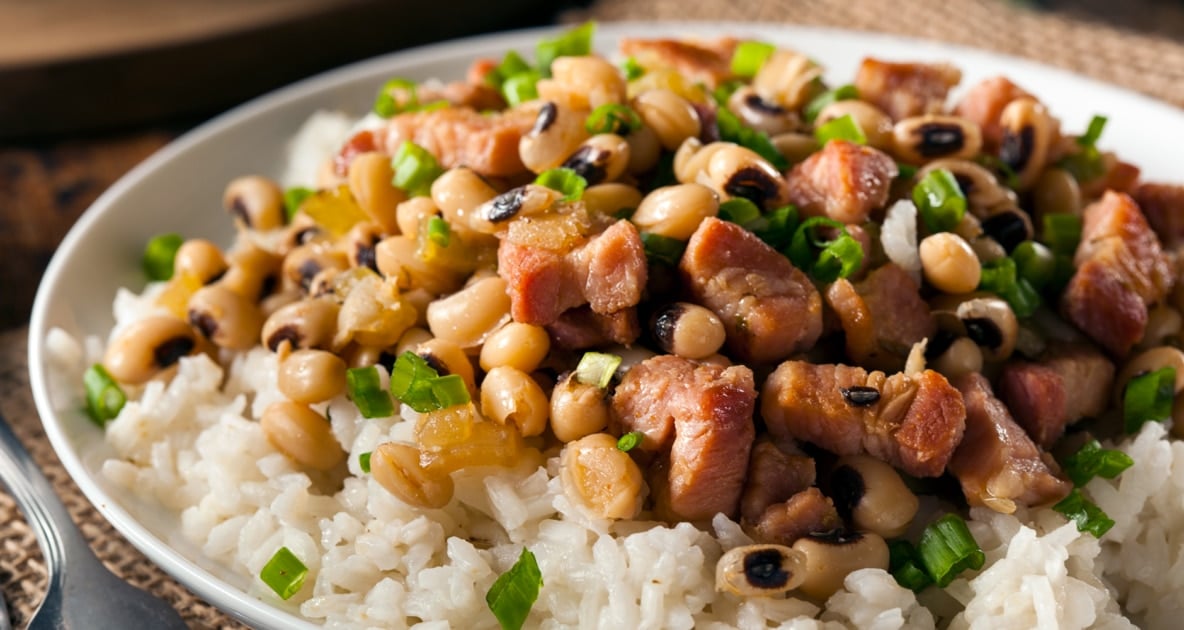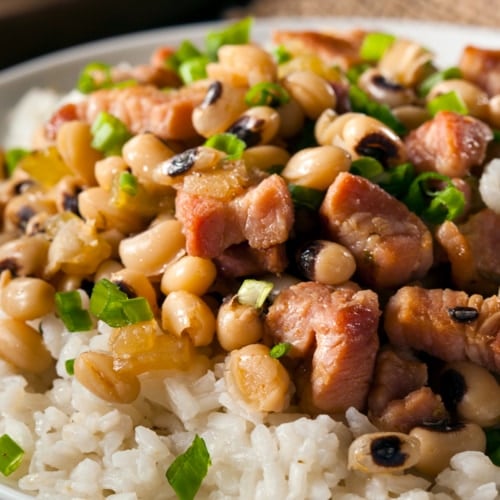Hoppin’ John: A New Year’s Tradition For Good Luck
Black-eyed peas and rice with fat back, salt pork or bacon is a staple in the south on New Year's.

Feast your eyes on this – black-eyed peas and rice, sizzling with fatback, salt pork or bacon. A staple in the South on New Year’s, this humble dish carries with it a history and tradition that’s just as rich as its flavors. But why is it considered a bringer of good luck, you might ask? Let’s embark on a culinary journey to discover the roots of this timeless delight!
Picture this: The warmth of the Thanksgiving turkey. The mouth-watering aroma of the Christmas ham. And then, New Year’s arrives and what’s on the menu? Black-eyed peas!
It might seem like an unusual choice to celebrate the New Year with these small legumes, but for generations, this has been a cherished tradition in the Southern United States. The belief goes that welcoming the New Year with a hearty serving of black-eyed peas, or “cowpeas” as they’re also known, promises a year filled with luck and prosperity.
Read about other lucky foods for the new year.
where did this fascinating tradition begin, you wonder?
The true origins of this custom are shrouded in mystery. One popular tale suggests that during the Civil War, Confederate soldiers considered themselves lucky to survive the harsh winter of 1864, thanks to plentiful fields of black-eyed peas. These were one of the few food sources left untouched by General Sherman’s Union Troops. However, most gastronomical historians point towards Africa for the birthplace of this tradition. Black-eyed peas are believed to have been brought to America by enslaved Africans working the rice plantations. These humble peas were a staple in their diet and a symbol of survival and resilience in the face of adversity.
So, the next time you sit down to a plate of black-eyed peas and rice on New Year’s Day, remember you’re not just indulging in a tasty meal, but also participating in a tradition of hope and good fortune that spans centuries.
Boost Your Luck with these Foods
Immerse yourself in a Southern culinary tradition that could bring you good luck and prosperity! This cherished tradition insists that the first meal of the New Year should be a feast of black-eyed peas, greens, pork, and corn bread. Some folks prefer to serve their black-eyed peas over rice in a popular dish known as “Hoppin’ John” (see the recipe below). Each meal component is believed to bring a unique slice of good fortune:
- Black-eyed peas, resembling “coins,” signify potential monetary windfall.
- Greens—collards, mustard or turnip greens, and cabbage —represent the green of “dollar bills,” promising you a financially prosperous New Year.
- Pork, whether used to flavor the Hoppin’ John or the greens, symbolizes “forward motion” or “advancement” in the upcoming year.
- Corn bread, with its golden hue, embodies “gold.”
- And if you choose to add tomatoes to the meal, usually stewed with the Hoppin’ John, they are believed to symbolize “good health.”
But it’s not just what you eat—it’s how you eat it:
- The more you consume, the more luck and wealth you stand to gain.
- Some tradition-followers place a clean dime in the pot of peas right before serving. The lucky individual who finds the dime on their plate is believed to receive an extra dose of luck.
- Leaving 3 black-eyed peas on your plate after finishing your meal is said to ensure a New Year filled with luck, prosperity, and romance.
- • Eating Skippin’ Jenny (that’s leftover Hoppin’ John) on January 2 supposedly multiplies your chances for good luck as a reward for your frugality.
Ready to kick off a prosperous New Year? Why not try your hand at this traditional Hoppin’ John recipe?

Hoppin’ John
Ingredients
- 1 cup dry black-eyed peas
- 4 thick slices bacon, cut into small pieces
- 1 cup chopped onion
- 1/2 cup chopped green pepper
- 1 teaspoon salt
- 1 bay leaf
- 1 dash each of cayenne & black pepper
- 3 cups cooked rice
Instructions
- Wash peas, then cover with 5 cups water.
- Boil 2 minutes. Remove from heat and soak overnight.
- The next day, rinse the beans and drain thoroughly.
- Cook the bacon in a heavy pan until browned. Add onion and green pepper. Sauté until onion is tender.
- Add beans, 2 cups water, and seasonings. Cover and simmer 40 to 50 minutes or until peas are tender.
- Remove bay leaf; stir in rice.
- Continue simmering for about 10 minutes until all liquid has been absorbed.
- Serve with ham, cornbread and collard greens.
Who Was Hoppin’ John?
The origins of the name “Hoppin’ John” are a topic of debate among food historians. Some argue it comes from an old, hobbled man named Hoppin’ John who peddled peas and rice on the streets of Charleston. Others believe the name derives from the excitement of slave children who eagerly “hopped around the table” in anticipation of the dish.

Tiffany Means
Tiffany Means is a freelance writer and a degreed meteorologist. She specializes in weather forecasting and enjoys making the subject of weather (and the science behind it) more relatable. She currently resides in the Blue Ridge Mountains of North Carolina.






Going to try the HoppinJohn for New Years Day sounds delicious!!!!!!!